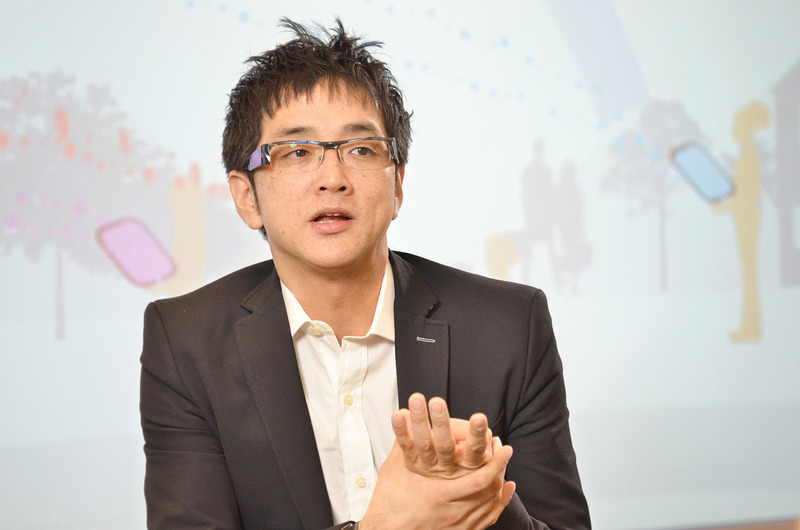Building the foundation for city development through open innovation × entertainment

Nobuhiko Watanabe
In this second installment of our series, we speak with Nobuhiko Watanabe, Director of the Open Innovation Lab (InnoLab) at Dentsu Inc. International Information Services (ISID), about specific initiatives.

Using IT to create new cities no one has ever seen
――Please tell us about ISID's approach to open innovation.
Watanabe: ISID is a systems integrator providing IT solutions to a wide range of clients across finance, manufacturing, services, and other sectors. While we traditionally focused on relatively rigid business operations for corporations, in 2011 we launched the Open Innovation Laboratory (InnoLab) with the vision: "Let's leverage the cutting-edge technologies and information networks converging here to freely create 'new value'!"
We aim to uncover "buried cutting-edge technologies" not yet seen in the market through the unique perspective of an IT company, bridge the gap between technology and advertising/marketing, and disseminate unprecedented culture. Ultimately, our goal is to use IT power to create a new city unlike anything seen before. To realize this dream, we are currently undertaking various initiatives.
――What specific initiatives are you undertaking?
Watanabe: Creating a city requires people. Entertainment is essential for gathering people. With this idea, we developed "Emitame," a smile-saving mirror signage, in collaboration with Koozyt, Inc. When you smile in front of the terminal, the smile recognition system reads information like the degree of upward movement of the corners of the mouth and converts it into points. We installed it in corporate cafeterias and live venues, conducting repeated proof-of-concept tests. We also trialed a charity program where accumulated points funded corporate greening initiatives or donations to support the Great East Japan Earthquake recovery. Thanks to this, we won the 2013 Good Design Award, giving us solid proof of concept.
The catalyst for innovation lies not in services, but in technology
――Mr. Watanabe, if there's any innovation you personally found fascinating, please tell us about it.
Watanabe: The gyro sensor built into smartphones has an interesting origin story. Originally, gyro sensors were precision components used to measure the angle and balance of instruments, boasting incredible accuracy. However, the gyro sensors adopted for smartphones were cheap and small but had poor sensitivity – essentially subpar products. What was considered nearly defective, with people saying "This won't sell," transformed into something remarkably useful the moment it was recognized as entertainment hardware for smartphones.
I find this transformation truly fascinating. I doubt the mindset of the precision machinery world, where even millimeter-level errors were unacceptable, could have conceived of the idea seen in mobile carrier commercials: where Tokyo Tower lights up or fountains shoot up in response to the audience waving their smartphones. The catalyst for innovation really is technology. It's not about wanting to use AR (augmented reality) or projection mapping for some service; it's about discovering a technology and creating a service from that. By sincerely engaging with the technology and translating it into a service, value beyond imagination is born.

The indispensable role of the facilitator in project success
――What's the key to making open innovation succeed?
Watanabe: It's about structuring it. Having at least one facilitator step in to firmly establish the project's core, map out a roadmap to success, and guide the team responsibly through to the end. If this is done, most projects will succeed, I believe.
――How should the relationship between the facilitator and team members be developed?
Watanabe: In my approach, I start with a workshop to align everyone's mindset, emphasizing, "Let's all stand on equal footing, sharing information and feelings as we work." Taking clear leadership there, assigning roles to members, and setting deadlines gets the project functioning. After that, it becomes a cycle of letting members move freely toward short-term goals and then combining the results to create new services.
――Conversely, are there things you should avoid doing?
Watanabe: Passive approaches like gathering tech-savvy people, casually throwing them into a project, and waiting for something to happen. Nothing will ever materialize that way. Also, halting project progress is a no-go. In open innovation environments, all sorts of things happen—unexpected troubles arise, new technologies emerge... Sometimes you'll need to drastically revise scenarios or roadmaps.
Even then, don't flinch. Analyze the situation around you and take the next step right then and there. Making decisions with speed builds trust among members, so I hope you can embrace change with a spirit that almost enjoys it.
(Continued in Part 3 )
Was this article helpful?
Newsletter registration is here
We select and publish important news every day
For inquiries about this article
Author

Nobuhiko Watanabe
Dentsu Inc. International Information Services, Inc. (ISID). Director, Open Innovation Research Institute. Left the company in December 2014.